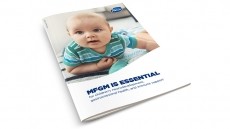How can the early life nutrition industry appease a new generation of parents?

Young people want brand owners to ‘switch from being part of the problem to becoming part of the solution’, argues FrieslandCampina Ingredients’ Floor van der Horst, who analyzed the company’s recently-conducted research on the future of the early life nutrition sector. The findings of Vision 2030 - Early Life Nutrition: Shining a light on new growth opportunities in a market under pressure depict the sector’s reshaped future, enabling brand owners to prepare their businesses and innovation pipelines for its next era.
“The people who will be parents in 2030 are currently in their 20s: generation Z,” Van der Horst told us. “Trends analysis by Ipsos on a global level and in five key markets, in combination with consumer focus groups, reveals beliefs, attitudes and priorities that differ quite significantly from those of earlier generations. These consumers have faced unprecedented circumstances in early adulthood: political unpredictability, climate concerns, a pandemic and global recession. These experiences are shaping their attitudes to their futures, including parenting.”
Gen Z isn’t solely focused on parenting, however; Van der Horst explains that this generation is equally focused on addressing global issues, such as the environment, mental health, and potential behavioral issues associated with children’s overuse of technology. “As a result, these individuals prioritise matters like financial independence, holistic health, emotional well-being and ethical responsibility,” she told us.
“The watchword is balance: success is important, but is not only measured financially or professionally, and it must not come at the expense of happiness or to the detriment of people or planet.” – Floor van der Horst, FrieslandCampina Ingredients
“Critically, young people want brand owners to switch from being, in their view, part of the problem, to becoming part of the solution.”
Although cautiously optimistic, Gen Z is also sceptical, meaning brands will need to provide credible claims that show them as trustworthy and ethically responsible,” she added. “Clear and evidenced sustainability claims on pack, for instance, must replace woolly goals and ambiguous statements.”
Gen Z’s focus on sustainability is already transforming the food sector, and Van der Horst predicts the same will happen in the early life nutrition space. “Sustainability will fuel further demand for alternative proteins in the coming years, as well as the use of more natural and locally-sourced ingredients. This, in turn, will be manifested in a growing number of hybrid (plant:dairy) and plant-based offerings,” she explained. “It will be important, however, to study the safety and digestibility of plant-based infant milk formulas (IMF) to ensure there is no compromise in their nutritional quality.”
Tech-forward nutrition
According to Seven Hills Strategies, which looked at this aspect of the Vision 2030 research, as consumers continue to expect more from the foods they eat and the nutrition they provide to their children, early life nutrition brands will increasingly leverage technological advancements.
“The ‘closer to breastmilk’ trend will continue, and technology will be fundamental in the aim to preserve bioactive proteins and native structures during processing,” explained Van der Horst. “Formula recipes should ensure an optimal composition (and functionality) of lipids, proteins and human milk oligosaccharides (HMOs) and reflect regional breastmilk profiles.
“Expansion of cell-based production of human milk components can be expected, using technologies such as precision fermentation and cell culture. Precision fermentation has already enabled the commercialisation of HMOs, and scientists are now exploring how this and other cell-based technologies could also produce alternative and futureproof proteins suitable for early life nutrition.”
The recently-announced partnership between FrieslandCampina Ingredients and Triplebar Bio Inc is one of the industry’s first examples of this strategy.
Universal changes to shape the sector
FrieslandCampina Ingredients, in collaboration with Annalise Market Intelligence, has defined three key types of markets with distinctly different characteristics. “Countries like the US, the UK and Mexico have more developed early life nutrition markets than India, Indonesia, Nigeria and Vietnam, for instance,” Van der Horst explained. “China’s sheer size puts it into a category of its own.”
“The future of these markets is equally disparate, so propositions need to be tailored to their specific needs. In China, premiumisation will continue, and market regulations will increase the cost of compliance, so it is predicted that large domestic ELN players will come to the fore over the coming years. Growth opportunities exist here in child nutrition as China’s birth rate remains low. In emerging markets, growing birth rates and rising dairy consumption set a positive scene, especially as interest grows in highly nutritious solutions for children after infancy. Finally, addressing specific nutritional needs through the selection of targeted ingredients will become a focus in both China and developed markets.”
Taking into account the distinctions between countries and regions, six core attributes will characterize successful early life nutrition brands, the company says.
“Portfolios will, as standard, include mental health propositions, as more and more consumers understand and prioritise this area of health,” Van der Horst predicts. “Hybrid formulations will move out of their current niche into the mainstream, driven by growing consumer awareness of the environmental impact their food choices have.
“By 2030, functional ingredients derived from alternative routes will be commercially available and incorporated into the most cutting-edge infant nutrition offerings. Technology holds great promise here.” – Floor van der Horst, FrieslandCampina Ingredients
“Global market strategies will be less appropriate at the turn of the decade. Disparities between countries are too wide, so increasingly localised strategies will be needed to ensure brands retain their relevance to the largest possible number of consumers.
“Similarly, the mid-price segment is unlikely to exist ten years from now as the ELN industry becomes hourglass-shaped. Premiumisation and ultra-premiumisation will define the Chinese market, and affordable solutions cater to the needs of emerging markets.
“The middle ground will be uncomfortable territory. However, opportunity exists in many countries in child nutrition. With volume increases of 8% expected in YCF and potential new applications for older children, looking beyond the traditional definition of ‘early life’ will be a lucrative evolution for ELN brands over the coming years."










